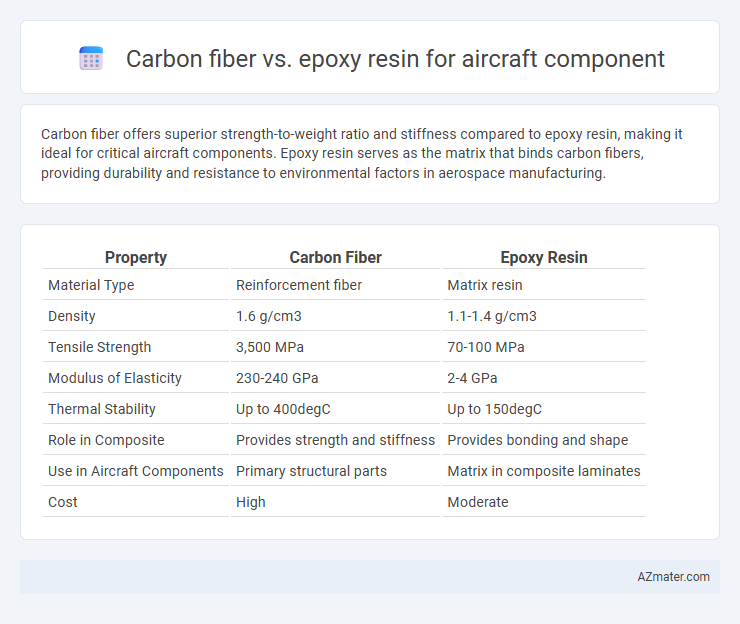Carbon fiber offers superior strength-to-weight ratio and stiffness compared to epoxy resin, making it ideal for critical aircraft components. Epoxy resin serves as the matrix that binds carbon fibers, providing durability and resistance to environmental factors in aerospace manufacturing.
Table of Comparison
| Property | Carbon Fiber | Epoxy Resin |
|---|---|---|
| Material Type | Reinforcement fiber | Matrix resin |
| Density | 1.6 g/cm3 | 1.1-1.4 g/cm3 |
| Tensile Strength | 3,500 MPa | 70-100 MPa |
| Modulus of Elasticity | 230-240 GPa | 2-4 GPa |
| Thermal Stability | Up to 400degC | Up to 150degC |
| Role in Composite | Provides strength and stiffness | Provides bonding and shape |
| Use in Aircraft Components | Primary structural parts | Matrix in composite laminates |
| Cost | High | Moderate |
Introduction to Carbon Fiber and Epoxy Resin in Aerospace
Carbon fiber composites, known for their exceptional strength-to-weight ratio and high stiffness, are extensively utilized in aerospace for manufacturing lightweight aircraft components that enhance fuel efficiency and structural performance. Epoxy resin serves as the primary matrix material in these composites, providing superior adhesion, chemical resistance, and thermal stability, which are critical for maintaining integrity under extreme aerospace conditions. The combination of carbon fiber and epoxy resin results in a composite material that meets stringent aerospace standards for durability, fatigue resistance, and mechanical strength.
Material Composition and Properties
Carbon fiber, composed of thin strands of carbon atoms bonded in a crystalline formation, offers exceptional tensile strength and low weight, making it ideal for high-performance aircraft components. Epoxy resin serves as the matrix material that binds carbon fibers together, providing excellent adhesion, chemical resistance, and durability under stress while maintaining lightweight properties. The combination of carbon fiber's high modulus and epoxy resin's strong bonding results in composite materials with superior stiffness, impact resistance, and fatigue life compared to traditional metals used in aerospace manufacturing.
Strength and Weight Comparison
Carbon fiber composites offer superior strength-to-weight ratios compared to epoxy resin alone, making them ideal for aircraft components requiring high tensile strength and minimal weight. The high modulus of carbon fibers provides exceptional stiffness and durability while epoxy resin acts as a strong matrix binding these fibers, ensuring structural integrity without significantly increasing weight. Combining carbon fiber with epoxy resin results in lightweight, high-strength materials that outperform traditional metals in aerospace applications, enhancing fuel efficiency and performance.
Durability and Fatigue Resistance
Carbon fiber composites exhibit superior durability and fatigue resistance compared to epoxy resin alone, making them ideal for aircraft components subjected to cyclic loading. The high tensile strength and stiffness of carbon fibers significantly enhance the structural integrity and longevity of parts, reducing the risk of crack propagation and material degradation over time. Epoxy resin acts as a matrix that binds carbon fibers, providing excellent adhesion and environmental resistance, but its mechanical performance is significantly amplified when reinforced with carbon fibers.
Thermal and Chemical Resistance
Carbon fiber composites combined with epoxy resin offer superior thermal stability critical for aircraft components exposed to high temperatures, with epoxy resins typically providing heat resistance up to 200degC or higher depending on formulation. Carbon fiber enhances chemical resistance by resisting corrosion and degradation from aviation fuels, hydraulic fluids, and cleaning solvents, while epoxy matrix contributes to maintaining structural integrity against moisture and chemical exposure. The synergy between carbon fiber's structural properties and epoxy resin's thermal and chemical resilience makes this combination optimal for aircraft parts demanding durability and safety under harsh environmental conditions.
Manufacturing Processes and Techniques
Carbon fiber composites for aircraft components are typically fabricated using techniques such as autoclave curing, resin transfer molding (RTM), and filament winding, which provide high strength-to-weight ratios and excellent fatigue resistance. Epoxy resin serves as the matrix material that binds carbon fibers, cured through controlled heat and pressure cycles to achieve optimal mechanical properties and dimensional stability. Manufacturing processes prioritize precision in fiber orientation and resin impregnation to enhance load-bearing capacity and reduce defects, essential for aerospace safety and performance standards.
Cost Implications and Economic Feasibility
Carbon fiber offers superior strength-to-weight ratio compared to epoxy resin, making it an economical choice for high-performance aircraft components despite its higher initial cost. Epoxy resin serves primarily as a matrix material in composites, with cost implications tied to its quality and curing process, impacting the overall manufacturing expenses. Evaluating the lifecycle cost reveals carbon fiber composites reduce maintenance and fuel costs, enhancing long-term economic feasibility for aerospace applications.
Applications in Modern Aircraft Components
Carbon fiber composites reinforced with epoxy resin dominate modern aircraft components due to their exceptional strength-to-weight ratio and corrosion resistance. Primary applications include fuselage panels, wing structures, and tail assemblies, where aerospace engineers leverage these materials for enhanced fuel efficiency and structural integrity. The combined use of carbon fiber and epoxy resin ensures improved fatigue resistance and damage tolerance critical for high-performance commercial and military aircraft.
Maintenance, Repair, and Longevity
Carbon fiber composites combined with epoxy resin provide superior strength-to-weight ratios essential for aircraft components, enhancing durability and reducing maintenance frequency. Epoxy resin's excellent adhesion and resistance to environmental factors contribute to long-term structural integrity, minimizing repair needs and extending service life. Maintenance protocols focus on inspecting for delamination and micro-cracks in carbon fiber layers, with epoxy resin facilitating effective repair through bonding and reinforcement techniques.
Future Trends in Composite Materials for Aviation
Carbon fiber reinforced polymers (CFRPs) combined with advanced epoxy resins remain the cornerstone of lightweight, high-strength aircraft components due to their superior tensile strength and fatigue resistance. Emerging trends highlight the integration of nanomaterials and bio-based epoxy formulations to enhance thermal stability and reduce environmental impact. Innovations in automated composite manufacturing and multifunctional materials are driving the next generation of aviation components with improved durability and performance.

Infographic: Carbon fiber vs Epoxy resin for Aircraft component
 azmater.com
azmater.com